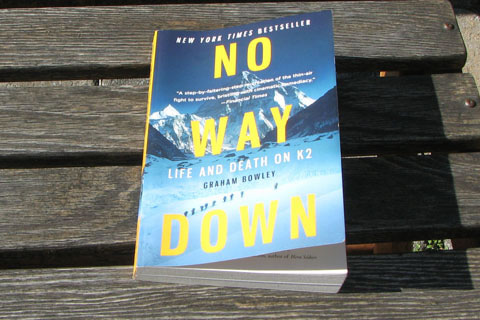| 550 | No Way Down, a review | 2012-01-04 |

K2 is the world's second tallest mountain. While hoards of guided climbers flock to Mount Everest, K2 sees far less activity. There are several reason for K2's less popular status - the climbing access to the mountain is through a roughed section of Pakistan, the standard route on K2 is more difficult and dangerous than the standard route on Everest, and K2 is number 2. Who wants to brag about climbing the second tallest peak??? The notoriety of K2 for being a harder mountain still lures climbers to the second tallest peak, despite it's dangers.
In 1996 eight climbers died on Mount Everest, as the world hung on the words of the internet reports. It was a tragic day with high profile guides dying as they tried to save their clients.
In 2008 there were twelve official expeditions and a handful of independent climbers trying to climb K2. On August 1st and 2nd eleven climbers died on the mountain. "No Way Down" by Graham Bowley tells the story of K2 on those tragic days.
In the book Bowley gives his analysis of the climb. He interviewed most of the surviving climbers to form his opinions.
"No Way Down" does a great job of explaining expedition life to the non-mountaineer. Bowley goes into detail concerning the affects of altitude on the climber including his ability to reason. He also details the climbing experience by explaining expedition logistics, food and water, physical effort, the cold, altitude, technical skills and camaraderie.
Bowley's analysis of the events seems sound; but that is of minor importance to me. I am okay with not knowing all of the details. It is enough for me to know that a climber died when ice fell from the serac (an ice cliff). The climbers attempting the summit that day were giving their all to climb the mountain. The ones who died, did so trying to achieve personal goals. No finger pointing, please.
Bowley also breaks down a number of the mistakes made on the mountain which led to some of the fatalities, such as, not having enough rope, not fixing the climber's ropes properly, the climber's reliance on the ropes, climber's ignoring turn around times, and more. For example, one group did not summit until eight o'clock, they did so knowing they were going to have spend a cold, cold night above 8,000 meters.
I am an armchair mountaineer. I enjoy reading about expeditions. From the early American K2 expeditions to the first ascents of Anapurna and Everest and the expeditions and remarkable achievements to all the high peaks, I followed the mountaineers through their trials. In "No Way Down" Bowley gave many points to ponder as he detailed the successes and failures on the mountain.
There were things that happened on the mountain that no one saw. Some deaths were not witnessed. Bowley tries to give his view; but he freely admits that it is just his opinion.
"No Way Down" was enjoyable. It was written so that all readers could understand "Life and Death" on the mountain. The book does not even have a glossary. Well done.
And to all of the climbers, sherpas, and high altitude porters on K2 in 2008, you were all heroes to me.
Happy No Way Down trails